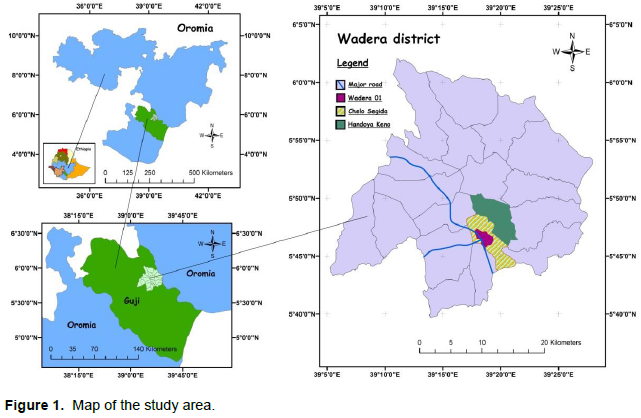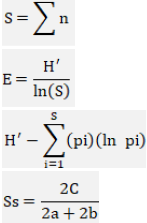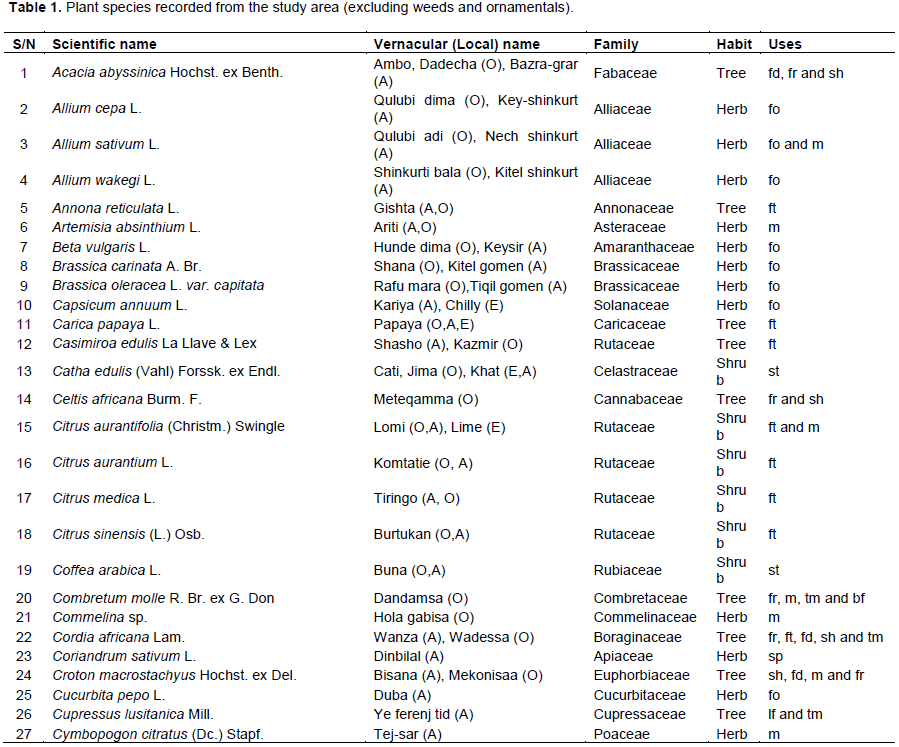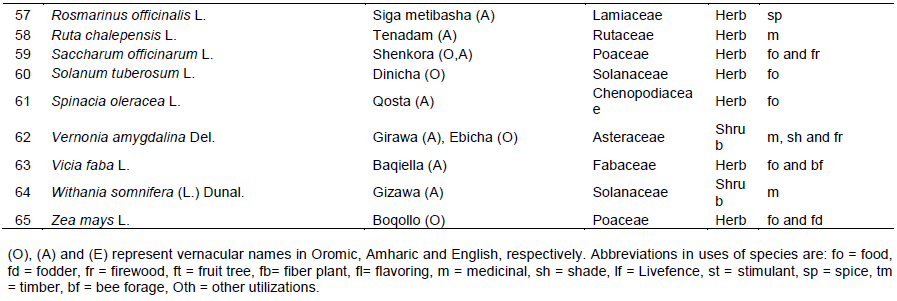ABSTRACT
This study was conducted in Wadera district of Oromia region in Ethiopia, with the objective of quantifying the diversity and floristic composition of home garden agroforestry systems. A stratified random sampling design was used to select 132 sample home gardens and a detailed inspection was conducted on diversity and floristic composition of the plant species using the Shannon-Wiener diversity index and Pielou’s Evenness index. A total of 65 cultivated plant species belonging to 36 families were recorded with an average of 28 plant species per individual’s home garden. Rutaceae was the dominant family with 6 species followed by Lamiaceae and Solanaceae. Shannon’s diversity indexes of 1.63 to 2.06 were recorded at the village level with an overall mean diversity index (H’) of 1.85 and evenness index (E) of 0.58. The findings from this study may help government and other stakeholders in providing baseline information, supported with scientific evidence, which further can contribute to policy and decision making process.
Key words: Agroforestry, home garden, diversity, floristic composition, Guji zone.
The floristic diversity and composition of home gardens differ from place to place depending mainly on different factors; e.g., farm size, family size, and access to markets (Tesfaye et al., 2010; Talemos et al., 2013). Both vertical and horizontal arrangements have resulted from a long history of farmers’ knowledge based on trial and error rather than being supported by scientific and empirical evidence. Individual farmers pursue their own way of species selection and arrangements, which lead to tremendous variation in the number, size, and placement of specific components of the arrangement. As these systems differ based on their species diversity and composition, their contribution to household subsistence, economic and environmental benefits differ as well.
In most parts of sub-Saharan Africa, particularly in Ethiopia, it is becoming difficult to meet the food demand of every household in the face of the increasing population and decreasing arable land, with limited land resources (Mersha, 2013; Sunderland et al., 2013); as a result, millions of farmers in Ethiopia are struggling to subsist. The pressure to meet the food demand of each family member saddles farmers’ survival strategies toward improper landuse and shifts in the farming system, primarily to mono-cropping of cash crops (Mersha, 2013; Mellisse et al., 2017).
Agroforestry allows the diversification of products and integration of trees in farms and rangelands that sustain production for increased social, economic and environmental benefits (WAC, 2019), and thus play a significant role in solving these persistent problems. This study focused on home garden agroforestry practice, which is characterized by its multi-layered floristic composition of species that are managed in intimate association with each other in a landscape that resembles a forest ecosystem that is located close to residential houses and plays an important role in the production of subsistence and cash crops. These farm places are a source for medicine, spices, fiber, fodder for livestock, construction wood; while maintaining year-round production by stabilizing microclimate and nutrient cycling under the vegetation (Agbogidi and Adolor, 2013; Tesfaye et al., 2013). Therefore, this study was carried out to quantify the diversity and floristic composition of cultivated home garden species in Wadera district, and addressed the following question:
(1) What is the diversity and floristic composition of cultivated species in Wadera home gardens?’
The study area
This study was conducted in Wadera district (05° 40' to 06° 03' N and 39° 05' to 39° 28' E) in the East Guji administrative zone of Oromia Regional State, Ethiopia (Figure 1). The district is located at 535 km South of the country capital city, Addis Ababa. Its altitude ranges between 1,489 and 1,914 m above sea level. Based on the CSA (2007), the district has a total population of 50,075, of which about 10% is suburban. The district has a total area of 95,169 ha. The mean annual rainfall of 1,000 to 1,400 mm occurs in a bimodal pattern, and the region enjoys a mean annual temperature of 19°C. The long rainy season starts from mid-March to May, while the short rainy season occurs from mid-September to October. Between the beginning of December and mid-March the area encounters high temperatures and strong winds. The major soil types of the district are Oxisols and Alfisols, characterized by their red brown colors. High forests, grassland, exposed sand soil, riparian woodland or bush land and cultivated land are available in the district. The land use includes: cultivated land 31,426.2 ha (33.39%), forest land 27,979 ha (29.73%), grazing land 24,012 ha (25.51%), and others 10,417.2 ha (11.07%).

Sampling
A stratified random sampling technique was employed following Alexiades (1996). Villages in the district were grouped into two dominant groups based on their farming practice: pure farmers and semi-pastoralists. A total of 7 villages were identified in the category of pure farmers’ villages and further divided into 2 sub-groups (suburban and rural). Three villages, namely: Wadera 01, Chelo Segida and Handoya Keno were selected for detailed inspection, and used for the diversity and floristic composition analyses. A total of 132 households were randomly selected for detailed inventory on diversity and floristic composition of home garden species using Watson’s (2001) formula.
where n = sample size required, N = total number of population (2150), P = estimated variance in population, as a decimal: (0.1) for 90-10%, A = precision desired expressed as decimal: (0.05 for 5%), Z = based on confidence level: (1.96) for a 95% confidence level, R = response rate: (0.99 for 99% response).
Data collection
Both qualitative and quantitative data regarding floristic composition of home garden species were collected from primary and secondary data sources. All vegetation data were collected from 60 home gardens using a quadrat method (Oosting, 1956). At each home garden, a random quadrat of 100 m2 (10 m × 10 m) for trees, 25 m2 (5 m × 5 m) for shrubs and 1 m2 (1 m × 1 m) for herbs, were laid out and data on species name, number of individuals of each species per quadrat and number of structural layers based on the plant height were collected. All recorded species were identified using Azene (2007) and flora of Ethiopia and Eritrea. Furthermore, voucher specimens were collected and taken to the national herbarium of Addis Ababa University to confirm the identification. Diameter at breast height (DBH) of trees and shrubs were measured using diameter tape and height of plants was measured using measuring poles (for small plants < 3 m) and clinometers for larger plants (height > 3 m: such as trees and shrubs).
Data analysis
The qualitative and quantitative data collected for the study were described and analyzed by calculating percentages and descriptive statistics (mean and standard deviation). Differences between group means were determined by F-test (to compare two groups) and one-way analysis of variance (ANOVA; to compare more than two groups), followed by post-hoc least significant difference (LSD) test. The relationships of diversity indices with socioeconomic factors were determined using separate linear correlation (Pearson’s correlation) for each index. Data were analyzed using Statistical Package for Social Sciences (SPSS).
Important quantitative analysis like frequency of cultivated species was determined following Martin (1995). Floristic species (cultivated) richness (S), Shannon-Wiener diversity index (H’) and Pielou’s evenness index (E) were calculated using Magurran (1988). This method was selected because it provides an account for both abundance and evenness. It also does not disproportionately favor some species over the others as it counts all species according to their frequencies. Sorensen’s index of similarity (Ss) was calculated to compare the vegetative composition of home garden of the villages taking into consideration all species found in all representative villages (Sorensen, 1948). Data were analyzed using Statistical Package for Social Sciences (SPSS Version 20.0).

where S = Species richness, n = number of individuals of each species per quadrat, H’= Shannon-Wiener diversity index, i = Species, pi = proportion of individuals of the ith species and ln = natural logarithm, E = Species evenness, Ss = Sorensen’s similarity coefficient, a = Number of species in community a, b = Number of species in community b, C = Number of common species in both communities.
Structure of Wadera home gardens
From the 132 households inspected, 95 of them (72%) arranged their gardens as a combination of side and back yards. Other management layouts such as front yards and enclosed (surrounded) yards were also observed in the study area. The average size of home garden in the study area was 0.51 ha (0.28, 0.54 and 0.71 ha for Wadera 01, Chelo Segida and Handoya Keno villages, respectively), with ranges between 0.25 and 1.5 ha (Table 2).
Considering the living house as a reference point, the spatial horizontal structure of a Wadera home garden is characterized into four main parts, namely: front garden (1), medicinal and spices garden (2), food and cash crops garden (3) and trees (fruit) garden (4) (Figure 2).
Based on height of the flora, three distinct strata (<3, 3-10 and > 10 m) were stratified. Fully grown tree species like Cordia africana, Podocarpus falcatus and Croton macrostachyus dominate in the upper stratum. In the middle, fruit trees like Persea americana and Citrus medica and cash crops like Coffea arabica and Catha edulis are dominant. In the lower layer (ground 3 m), food crops like Zea mays, spices and medicinal plants are planted and managed (Figure 3). This finding agrees with Fernandes and Nair (1986) and Montagnini (2006) who noted that most tropical home gardens are vertically stratified into 3 to 4 strata.
Diversity and floristic composition of the home garden
This study revealed that Wadera home gardens have a high floristic species diversity amounting to a total number of 65 cultivated species (28 herbs, 17 trees, 18 shrubs, and 2 lianas) comprising 36 families (Table 1). The maximum number of species per home garden was recorded from Handoya Keno village (47) and minimum from Wadera 01 (13), with an overall average species number of 27.5. Rural home gardens in the study area were richer (p< 0.05) in floristic species as compared with sub-urban one. Shannon’s diversity index of the sub-urban village (Wadera 01) was 1.63 while that of the rural villages, Chelo Segida and Handoya Keno, was 1.99 and 2.06, respectively (Table 2). The Shannon’s diversity index at Wadera 01 village was significantly lesser (p< 0.01) than both Chelo Segida and Handoya Keno villages. However, species evenness between selected villages was not significantly different. Sorensen’s similarity index values for pairs of villages varied between 0.67 and 0.93. The result in overall floristic composition across 132 home gardens in the three villages proved that similarity among groups of species was high (Ss = 0.93) between Chelo Segida and Handoya Keno villages followed by Wadera 01 and Chelo Segida (Ss = 0.75) and Wadera 01 and Handoya Keno (Ss = 0.67) villages (Table 3).
Regarding floristic similarity of species, all villages in the study area shared a total of 33 species. The two rural villages, Chelo Segida and Handoya Keno, shared a total of 54 species; while Wadera 01 and Chelo Segida shared a total of 37 species. Other than common species shared between all three villages, there were no species shared between Wadera 01 and Handoya Keno villages. Wadera 01 and Handoya Keno had 3 species each that are not shared with any of the villages; while Chelo Segida had only 1 species (Figure 4).
Similar to most multistory tropical home gardens, Wadera home gardens are rich and diverse in floristic species, especially in rural home gardens. This could be best attributed to the family sizes (households’ food supply and food preferences of individuals in a household), lack of market access (alternative livelihood options) and home garden size conditions. Households with many family members include children, adults, and elders whose food preferences mostly differ from each other. To satisfy the need of each member (group), the Wadera home garden plays an important role in ensuring food security of the household by providing a variety of food crops so that the family members do not skip a day without eating. This is in agreement with Eyzaguirre and Watson (2001) and Krishnal et al. (2012) who noted that home gardens have an important role in achieving a sufficient food supply for the household’s family. In general, this study produced similar result as that of Tesfaye (2013), who reported that family size influences diversity and dynamics of species in home gardens of Sidama, Southern Ethiopia. In the Wadera district, farmers in rural areas are expected to walk 15 to 20 km in a single trip to reach the central market, which is located in Wadera 01 village. Because of the distance, rural gardeners mostly visit the central market once or twice a month. Their access to livelihood commodities is limited due to their geographic location. But they cultivate as many species as they can in their gardens to compensate for their limitations and subsist and try to minimize the frequency of market visits. This means home gardens are playing an invaluable role in saving labor and time spent that could be wasted due to frequent market visits that would be needed to survive. This result is in agreement with previous studies (Eyzaguirre and Watson, 2001; Oliver and Ban, 2004; Tesfaye et al., 2006; Talemos et al., 2013; Tesfaye, 2013), which indicated that rural societies are more dependent on their home garden products and farms due to geographic location (remoteness from markets). In contrast, suburban gardeners in the study area have direct access to a marketplace (district’s only market is available in a suburban village) where they can obtain most of their livelihood requirements and hence their gardens are dominated by ornamental and medicinal plant species. Rural home gardens of Wadera district are significantly larger in size (p < 0.001) from sub-urban ones. It is obvious that larger home gardens require a more substantial labor force as compared to smaller ones. In the study area, family size and size of home gardens are positively correlated (r = 0.51, p < 0.01), which is the same result reported by Kehlenbeck and Mass (2004) in their studies of Sulawesi, Indonesia home gardens.
Floristic similarity of species was best attributed to the physical proximity of villages to each other. As the distance between villages decreased, similarity in overall floristic composition of home gardens increased. This similarity could be best described by two major reasons: similarity in agroecological conditions of the district and ease of information and experiences sharing among Wadera farmers. In the same agroecological condition, the same type of species can adapt and flourish. Zebene (2003) noted that neighboring farmers, residing in the same village, have a tendency of sharing information regarding species performance, adaptability, and economic and nutritional values. This result is in agreement with Habtamu (2008) and Tesfaye (2013) who reported that closely located villages showed a high value of overall floristic similarity of species as compared to distantly located ones. This result helps researchers and development agents (experts) in providing information on how to promote and disseminate new agroforestry technologies by taking their information sharing culture into consideration.





Wadera home gardens are rich and diverse in floristic composition and distribution (a total of 65 cultivated floristic species). Suburban home gardens accounted for an average of 24 species, having mean Shannon’s diversity (H’) and Evenness (E) indices of 1.63 and 0.56, respectively. Rural home gardens had an average of 58 cultivated floristic species with mean Shannon’s diversity (H’) and Evenness (E) indices of 2.03 and 0.59, respectively. Mean results of species richness (S) showed an increment in rural home gardens. Floristic diversity of species was evenly distributed across all home gardens.
The findings in this study help the scientific community and policy makers in identifying what type of agroforestry systems are available in their district, and thus contributes its own part in promoting and disseminating agroforestry technologies easily in Wadera communities taking into consideration their local knowledge, practice and tendency to adapt new information and technologies focusing on agroforestry. Guji administrative zone, where the present study was conducted, shares boundaries with Gedeo administrative zone, which is known by its home garden agroforestry practices. In this zone, 86% of its population is involved in the practice, and slopes as steep as 60 to 80° are under home garden utilization. As a result, both soil and water resources are reported to be well conserved (Melese and Daniel, 2015; Sileshi, 2016; Yirefu et al., 2016). This could result in knowledge and information transfer among farmers. The finding from this study may help government and other stakeholders in providing baseline information, supported by scientific evidence, which can further contribute to more informed policy and decision making processes. To sum up, the findings from this study inform, encourage and create fertile insights to enhance the effort that the country is making in promoting agroforestry (GTP II, 2016).
The authors have not declared any conflict of interests.
Villagers and leaders of Wadera district are appreciated for their accommodation and volunteer participation in quantifying the diversity of their home garden farms and provision of reliable information on the district’s home gardens.
REFERENCES
|
Agbogidi OM, Adolor EB (2013). Home garden in the maintenance of biological diversity. Applied Science Reports 1(1):19-25.
|
|
|
|
Alexiades M (1996). Collecting ethnobotanical data. In: Selected Guideline for Ethnobotanical Research: A field manual. Alexiades MN, Sheldon JW eds, The New York Botanical garden, Bronex; NY, USA, pp. 53-94.
|
|
|
|
|
Azene BT (2007). Useful trees and shrubs of Ethiopia: identification, propagation and management in 17 agroecological zones. RELMA in ICRAF Project, Nairobi. P. 552.
|
|
|
|
|
Central Statistical Agency (CSA) (2007). Summary and statistical report of the 2007 population and housing census: population size by age and sex, Addis Ababa. p. 113.
|
|
|
|
|
Eyzaguirre P, Watson J (2001). Home gardens and agro-biodiversity: an overview across regions. In: Watson JW, Eyzaguirre PB eds. Proceedings of the Second International home garden Workshop. Biodiversity international, Rome, Italy, pp. 10-13.
|
|
|
|
|
Fernandes ECM, Nair PKR (1986). An Evaluation of the Structure and Function of Tropical home gardens. Agricultural Systems 21:279-310.
Crossref
|
|
|
|
|
Growth and Transformation Plan (GTP II) (2016). Federal Democratic Republic of Ethiopia Growth and Transformation Plan II 2015/16 - 2019/20,. Volume I, Addis Ababa, Ethiopia. P. 236.
|
|
|
|
|
Habtamu H (2008). Home garden and agrobiodiversity conservation in Sebeta town, Oromia national regional state, Ethiopia [M.Sc thesis]. Addis Ababa, Addis Ababa University.
|
|
|
|
|
Kehlenbeck K, Mass BL (2004). Crop diversity and classification of home garden in Central Sulawesi, Indonesia. Agroforestry Systems 63:53-62.
Crossref
|
|
|
|
|
Krishnal S, Weerahewa J, Gunaratne LHP (2012). Role of home garden in Achieving Food Security in Batticaloa District, Sri Lanka. International Conference on Economics and Finance Research. IPEDR Vol.32, IACSIT Press, Singapore.
|
|
|
|
|
Magurran AE (1988). Ecological diversity and its measurement. Princeton University press, Princeton NJ. P 172.
Crossref
|
|
|
|
|
Martin GJ (1995). Ethnobotany: A Method Manual. Chapman and Hall, London P 268.
|
|
|
|
|
Melese M, Daniel F (2015). Plant Species Diversity and Composition of the home garden in Dilla Zuriya Woreda, Gedeo Zone, SNNPRS, Ethiopia. Plant 3(6):80-86.
Crossref
|
|
|
|
|
Mellisse BT, Van de Ven, GWJ, Giller KE (2017). Home garden systems dynamics in southern Ethiopia. Agroforestry System. 92(Issue 6):1579-1595.
Crossref
|
|
|
|
|
Mersha G (2013). Recent transitions in Ethiopian home garden Agroforestry: Driving forces and changing gender relations (M.Sc thesis). Sweden P. 53.
|
|
|
|
|
Beyene TM, Gerrie WJ, Van de Ven, Ken EG, Katrien D (2017). Home garden systems dynamics in southern Ethiopia. Agroforestry Systems. https://doi.org.10.1007.s10457-017-0106-5
|
|
|
|
|
Montagnini F (2006). Home gardens of Mesoamerica: Biodiversity, Food security and Nutrient management. In Kumar BM, Nair PKR (eds.), Tropical home gardens: A Time-Tested Example of Sustainable Agroforestry. Springer Science, Dordrecht, pp. 61-84
Crossref
|
|
|
|
|
Oliver TC, Ban N (2004). Cultivated Plant Species Diversity in home garden of an Amazonian Peasant Kebele in Northeastern Peru. Economic Botany 58(3):420-434.
Crossref
|
|
|
|
|
Oosting HJ (1956). The Study of Plant Communities: An Introduction to Plant Ecology, 2nd edn. WH Freeman and Company, San Francisco, CA.
|
|
|
|
|
Sileshi D (2016). Home garden agroforestry practices in the Gedeo zone, Ethiopia: a sustainable land management system for socio-ecological benefits. In: UNU-IAS and IR3S/UTIAS 2016, Socio-ecological production landscapes and seascapes (SEPLS) in Africa. United Nations University Institute for the Advanced Study of Sustainability, Tokyo, pp. 28-36.
|
|
|
|
|
Sorenson T (1948). A method of establishing groups of equal amplitude in a plant society based on similarity of species content. K Dan Vidensk Selsk Biol Skr 5:1-34.
|
|
|
|
|
Sunderland T, Powell B, Ickowitz A, Foli S, Pinedo-Vasquez M, Nasi R, Padoch C (2013). Food security and nutrition: The role of forests, Discussion Paper, CIFOR, Bogor, Indonesia.
|
|
|
|
|
Talemos S, Sebsebe D, Zemede A (2013). Home gardens of Wolayta, Southern Ethiopia: An ethnobotanical profile. Academia Journal of Medicinal Plants 1(1):14-30.
|
|
|
|
|
Tesfaye A, Wiersum KF, Bongers F, Sterck F (2006). Diversity and dynamics in home gardens of Southern Ethiopia. In: BM Kumar and PKR Nair (eds), Tropical home garden: A time-tested example of sustainable Agroforestry. Springer Science, Dordrecht, pp. 123-142.
Crossref
|
|
|
|
|
Tesfaye A, Wiersum KF, Bongers F (2010). Spatial and temporal variation in crop diversity in Agroforestry home garden of southern Ethiopia. Agroforestry Systems 78:309-322.
Crossref
|
|
|
|
|
Tesfaye A (2013). Determinants of crop diversity and composition in Enset-coffee Agroforestry home garden of Southern Ethiopia. Journal of Agriculture and Rural Development in the Tropics and Subtropics 114 (1):29-38
|
|
|
|
|
Tesfaye A, Sterck FJ, Wiersum KF, Bongers F (2013). Diversity, composition and density of trees and shrubs in Agroforestry home garden in Southern Ethiopia. Agroforestry Systems 87:1283-1293
Crossref
|
|
|
|
|
World Agroforestry Center (WAC) (2019). What is Agroforestry? Retrieved March 13, 2019 from
View
|
|
|
|
|
Watson J (2001). How to Determine a Sample Size: Tipsheet #60, University Park, PA: Penn State Cooperative Extension. Available at:
View
|
|
|
|
|
Yirefu T, Wondawek A, Bagale T (2016). Woody Plants Species Diversity Of home Garden Agroforestry In: Three Agroecological Zones of Dilla Zuria District, Gedeo Zone, Southern Ethiopia. International Journal of Fauna and Biological Studies 3(3):98-106
|
|
|
|
|
Zebene A (2003). Tree species diversity, Top soil Conditions and Arbuscular Mycorrhizal Association in the Sidama Traditional Agroforestry Land use, Southern Ethiopia [PhD thesis]. Uppsala, SLU, Sweden.
|
|
